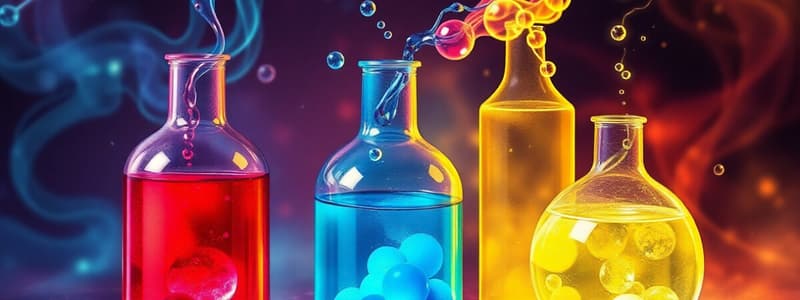Podcast
Questions and Answers
Which of the following metals can displace hydrogen from an acid?
Which of the following metals can displace hydrogen from an acid?
What is formed when sodium hydroxide reacts with hydrochloric acid?
What is formed when sodium hydroxide reacts with hydrochloric acid?
Which statement regarding the pH scale is correct?
Which statement regarding the pH scale is correct?
Which of the following acids is considered a strong acid?
Which of the following acids is considered a strong acid?
Signup and view all the answers
In the context of electrolysis, what is the role of inert electrodes?
In the context of electrolysis, what is the role of inert electrodes?
Signup and view all the answers
How can solid crystals of a dissolved salt be obtained from the solution?
How can solid crystals of a dissolved salt be obtained from the solution?
Signup and view all the answers
What happens during the process of smelting?
What happens during the process of smelting?
Signup and view all the answers
During a titration, what indicates that neutralization has occurred?
During a titration, what indicates that neutralization has occurred?
Signup and view all the answers
Study Notes
Reactivity Series
- Metals vary in their reactivity, some donate electrons more readily than others.
- A more reactive metal will displace a less reactive metal from a compound.
- Alkali metals react with water; potassium (more reactive than hydrogen) displaces hydrogen from water, forming potassium hydroxide and hydrogen gas.
- Metals less reactive than carbon can be displaced from their ores by carbon—this is smelting and is a reduction reaction (oxygen is lost).
- Metals more reactive than hydrogen can displace it from an acid, for example, most metals react with hydrochloric acid and sulfuric acid producing a salt.
Acids and Alkalis
- Alkalis have a pH greater than 7; acids have a pH less than 7.
- Alkalis react with acids to produce a salt and water; the reaction is neutralization.
- Sodium hydroxide (alkali) and hydrochloric acid (acid) form sodium chloride (salt) and water, resulting in a neutral pH of 7.
- Sulfuric acid forms metal sulfates, nitric acid forms metal nitrates.
- When a substance dissolves, its ions partially dissociate; water also dissociates into H+ and OH- ions.
- Solid crystals of a dissolved salt can be obtained by gentle warming to evaporate the water.
pH Scale
- The pH scale is logarithmic; a pH of 3 has 10 times the concentration of H+ ions compared to a pH of 4, and 100 times the concentration compared to a pH of 5.
- The higher the pH value, the greater the concentration of OH- ions (alkalis).
Acid Strengths and Concentrations
- A strong acid dissociates completely in solution, for example, hydrochloric, nitric, and sulfuric acids.
- A weak acid only partially dissociates, for example, ethanoic, citric, and carbonic acids.
- The pH of an acid depends on both its strength and concentration.
Titration (Triple Science)
- Titration is a method used to deduce the concentration of an acid or alkali.
- A measured volume of alkali is placed in a conical flask with an indicator (e.g., methyl orange).
- Acid of unknown concentration is added dropwise from a burette until the indicator changes color, signifying neutralization.
- By recording the volume of acid used, the concentration can be calculated using stoichiometry.
Electrolysis
- Electrolysis is used to purify metals or extract them from compounds.
- Ionic compounds, when molten, can conduct electricity as the ions can move.
- Inert electrodes (e.g., carbon) are used to pass a current through the molten compound.
- Positive metal ions (cations) move to the cathode (negative electrode), receive electrons, and are reduced to form atoms.
- Negative ions (anions) move to the anode (positive electrode), lose electrons, and are oxidized.
- In the electrolysis of aluminium oxide, aluminium is formed at the cathode and oxygen gas is formed at the anode.
- The reactivity of the ions determines which ion will be reduced or oxidized at the electrodes.
- In an electrolyte solution, if the metal is less reactive than hydrogen, it will form on the cathode instead of hydrogen gas.
- Halogen ions like Cl- will be oxidized at the anode.
- If no halide ion is present, oxygen from the OH- will be oxidized at the anode.
Studying That Suits You
Use AI to generate personalized quizzes and flashcards to suit your learning preferences.
Description
Explore the fascinating world of metals and their reactivity with acids and alkalis. This quiz covers key concepts such as the reactivity series, displacement reactions, and the neutralization process between acids and alkalis. Test your understanding of how these substances interact in chemical reactions.



